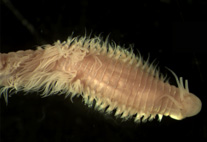Abstract
A new species in the family Bathycrinidae is described from abyssal depths from the Bahamas. It is referred to the recently established genus Discolocrinus, which formerly comprised a single species D. thieli Mironov, 2008 from the Eastern Pacific. Discolocrinus iselini n. sp. is characterized by large body size, high tegmen with tube-like upper region, extremely elongated IBr1 and IBr2, large knobby processes on primibrachials, and overgrowth of soft tissue on the pinnules, the tissue containing numerous perforated or imperforate ossicles of varying size and form. Differences between Discolocrinus and other bathycrinids may seem to be of taxonomic importance at the family level, but knowledge of the morphology and variability of both species of Discolocrinus is incomplete and, until a richer material becomes available, the genus should remain in family Bathycrinidae. Representatives of five families with xenomorphic stalks were examined to characterize the genera on the basis of number or form of knobby processes. These processes occur in two families with differing external morphology: ten-armed Bathycrinidae and five-armed Bourgueticrinidae. They also occur in the comatulid family Atelecrinidae. This similarity might seem to indicate a close relationship between the three families. However, morphological analysis supports the separation of the families Caledonicrinidae and Septocrinidae from Bathycrinidae despite the fact that they share a xenomorphic stalk and IBr2ax. These conclusions are in agreement with results of recent molecular studies.

